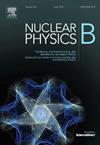Myrzakulov F(R,T)引力中的暗物质约束:基于观测数据的Weitzenböck时空中的vieelbein方法
IF 2.8
3区 物理与天体物理
Q2 PHYSICS, PARTICLES & FIELDS
引用次数: 0
摘要
我们探索了Myrzakulov F(R,T)引力中的暗物质现象学,该引力是通过Weitzenböck时空中的vieelbein方法表述的。在这种以扭转为基础的引力扩展中,暗物质作为一种几何效应而不是粒子物种出现,曲率和扭转对场方程做出了动态贡献。利用最近的数据,包括SPARC星系旋转曲线,普朗克CMB观测,以及DES和kids的弱透镜效应,我们通过MCMC分析来约束模型。我们的结果表明,在特定的参数选择下,该理论在不引入额外的暗物质的情况下复制了关键的宇宙学特征。这个框架为ΛCDM提供了一个可测试的替代方案,为结构形成、引力透镜效应和宇宙加速提供了新的见解——所有这些都植根于时空几何。本文章由计算机程序翻译,如有差异,请以英文原文为准。
Dark matter constraints in Myrzakulov F(R,T) gravity: A vielbein approach in Weitzenböck spacetime with observational data
We explore dark matter phenomenology in Myrzakulov gravity, formulated via the vielbein approach in Weitzenböck spacetime. In this torsion-based extension of gravity, dark matter emerges as a geometric effect rather than a particle species, with curvature and torsion contributing dynamically to the field equations.
Using recent data—including SPARC galaxy rotation curves, Planck CMB observations, and weak lensing from DES and KiDS—we constrain the model through MCMC analysis. Our results show that, under specific parameter choices, the theory replicates key cosmological features without introducing additional dark sector matter.
This framework offers a testable alternative to ΛCDM, providing new insight into structure formation, gravitational lensing, and cosmic acceleration—all rooted in the geometry of spacetime.
求助全文
通过发布文献求助,成功后即可免费获取论文全文。
去求助
来源期刊

Nuclear Physics B
物理-物理:粒子与场物理
CiteScore
5.50
自引率
7.10%
发文量
302
审稿时长
1 months
期刊介绍:
Nuclear Physics B focuses on the domain of high energy physics, quantum field theory, statistical systems, and mathematical physics, and includes four main sections: high energy physics - phenomenology, high energy physics - theory, high energy physics - experiment, and quantum field theory, statistical systems, and mathematical physics. The emphasis is on original research papers (Frontiers Articles or Full Length Articles), but Review Articles are also welcome.
 求助内容:
求助内容: 应助结果提醒方式:
应助结果提醒方式:


